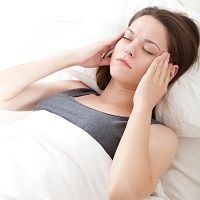Cluster Headache Remains an Enigma Despite Clinical Clues
A recent study in The Journal of Headache and Pain sheds some additional light on the chronobiological experience of patients with cluster headache (CH). However, it still leaves lingering mysteries around the pattern of pain CH that patients typically experience, the triggers of those headaches, and the mechanisms and interactions that drive headache frequency and severity.

A recent study in The Journal of Headache and Pain sheds some additional light on the chronobiological experience of patients with cluster headache (CH). However, it still leaves lingering mysteries around the pattern of pain CH that patients typically experience, the triggers of those headaches, and the mechanisms and interactions that drive headache frequency and severity.
“The interaction between sleep and headache is complex at any level, and evidence suggests that it may be of critical importance in our understanding of primary headache disorders,” the study authors noted. “With its stereotypical presentation and the ease with which the diagnosis can be made (even based on a short historical account), it may seem puzzling how CH can remain underdiagnosed, undertreated, and so enigmatic in nature. Accounts of the predictable attack patterns and how oxygen, almost by miracle, alleviates the headache have fascinated many, but true progress in our understanding of the disorder is lacking.”
The research, in the form of a questionnaire survey of 275 patients with CH and 145 controls at the Danish Headache Center and an in-hospital clinical investigation including 40 patients with CH, aimed to investigate the clinical presentation of chronobiological features, the presence of concurrent sleep disorders, and the relationship with particular sleep phases or phenomena in CH.
Among the key takeaways from the study:
- CH attacks themselves have been described to be mostly related to (nocturnal) sleep and to follow specific rhythms that often provide a high degree of predictability, but it is unclear whether circadian periodicity may be influenced by cultural factors.
- The study authors hypothesize that the central pathology for CH revolves around dysfunction of hypothalamic nuclei, producing conditions in which the painful attacks can arise or perhaps that these nuclei function as a “cluster generator.”
- “This dysregulation manifests itself as a complex, bidirectional relationship with sleep involving neuronal circuits in the overlap between headache pathology and the physiological regulation of sleep,” the study authors wrote.
- On average, patients with chronic cluster headache (CCH) scored 7-fold higher on the CH-index (935.6 ± 890.2) compared to patients with episodic (135.6 ± 204.4) (ECH). A difference between these two groups in attack duration with treatment was found, patients with CCH suffering longer attacks (44 vs. 32 min., P = 0.0052).
- 80% of patients reported that nocturnal sleep (as opposed to napping) was an attack trigger. Only a third of patients reported that napping triggered attacks.
- The strong association between cluster occurrence and the amount of daylight demonstrated in this study further strengthens a hypothesis of an intricate relationship between melatonin metabolism and CH.
- Patients suffered noticeably fewer attacks while admitted. “This is an interesting finding, as it implies that the increased sympathetic tone associated with a stay in new surroundings may affect the generation of cluster attacks,” the study authors noted.
The investigators concluded that the results support a causative role or very intricate involvement of central mechanisms in the pathogenesis of CH.
“However, due to the complex interactions and overlap of anatomy and physiology, there is considerable difficulty associated with determining the contributions of structures involved,” they wrote.
For now, the exact causes and triggers of CH will remain — as the study authors refer to it several times – an enigma.